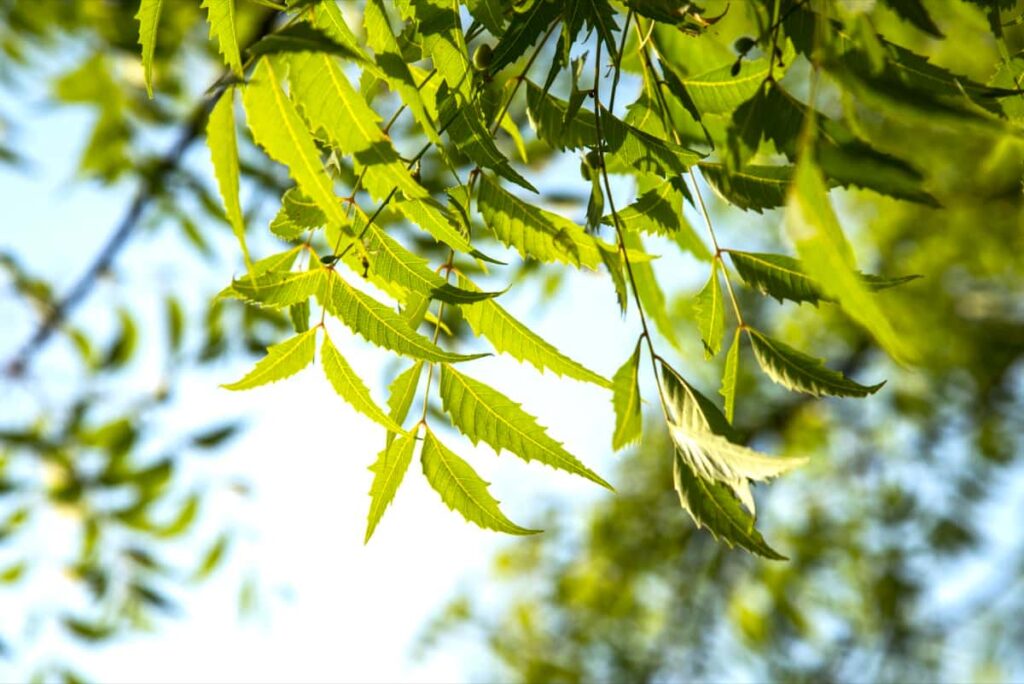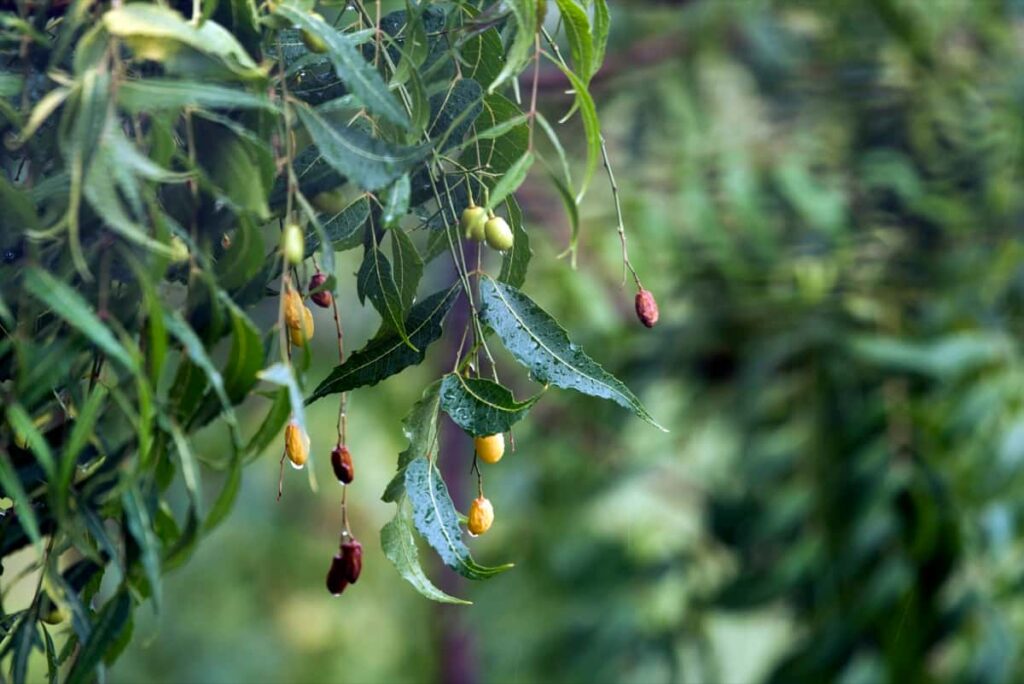The “green revolution” of the twentieth century included synthetic insecticides and fertilizers. Due to their effectiveness in controlling pests, they immediately became a standard commodity in all plant operations, from big agricultural fields to small home gardens. However, we have yet to understand the drawbacks and hazards of synthetic pesticides. Unfortunately, due to their chemical composition, it has been shown that they may trigger various harmful and deadly processes in natural ecosystems and human bodies.

Many formerly widely used pesticides have recently been classified as carcinogenic, while others threaten world bee populations. These are the primary reasons people are becoming more interested in organic gardening and utilizing natural pesticides and fertilizers. Because so many insects consume plants, they have evolved complicated chemical defense systems. We can extract some extremely effective pesticides from these plants that are harmless to humans. Let’s check out the recipe of making neem oil for plants.
How to Make Your Own Neem Oil for Plants
What is Neem Oil?
The oil squeezed from the leaves and seeds of the neem tree are a solid organic solution. It effectively controls illness and pests in your lawn or garden, like spider mites and aphids. It is native to India and South Asia and is one of India’s main elements in Ayurvedic treatment. A chemical called Azadirachtin is present in the neem seeds and affects insects differently.
Insects cannot lay eggs or reproduce when they come in contact with this chemical. Also, they will lose their ability to eat when neem leaves are used because of this chemical. In both cases, they cannot survive and grow, resulting in a steady reduction in the infestation. More than 400 insect species are thought to dislike neem oil in total.
What Type of Insects and Pests Does Neem Oil Prevent?
Neem oil can have a significant effect on small and soft-bodied insects. Examples are thrips, spider mites, aphids, scale, mealybugs, and whiteflies. When neem oil comes in contact with the body of these insects, it can have many adverse effects on their bodies, eventually killing them. Moths, cabbage, white butterflies, mosquitoes, and flies are supposed to be repelled by it.
When applied appropriately, however, neem oil is not dangerous to bees. Other useful insects, such as ladybugs, earthworms, spiders, parasitic wasps, and adult butterflies, are unaffected if they aren’t directly sprayed. As a result, spray it only at night, when beneficial insects are least active. Neem doesn’t do much to suppress caterpillars, except maybe repelling their adult butterfly.
In case you missed it: Inexpensive Raised Bed Garden Ideas: Cheap Budget Tips and Techniques

Furthermore, the protective glow that neem oil imparts to leaves makes them less vulnerable to fungal diseases like powdery mildew, rust, and blight. It can help prevent or delay the development of fungal illnesses, but it’s only modestly efficient at treating an epidemic once it’s started.
What are the Things You Need to Prepare Neem Oil at Home?
Spray bottles and gloves are required for this activity. One gallon of water, 1-3 spoonfuls of home-pressed neem oil, and 1-2 spoons of mild detergent. As needed, gradually increase the quantity.
How to Make Neem Oil for Plants at Home
Neem oil is a low-cost insecticide. You may buy neem oil sprays from a garden center, but producing your own is a relatively simple process. You can manage the quality of the components, the concentration levels, and the cost this way. Making your neem oil spray is typically significantly less expensive in the long term than buying a store-bought version.
Oil and water do not mix, as we were taught in science class. Or, at the very least, with difficulty. Similarly, you can only mix and spray some things in your garden. Therefore, it must thoroughly emulsify before spraying the neem oil mixture on your plants. This is how you make your neem oil from scratch.
- Mix Soap and Water: To efficiently combine with water, neem oil requires an emulsifying ingredient, such as mild dish soap. Use 1-2 spoons of dish soap with one gallon of warm water in the garden sprayer and mix it well.
- Add Neem Oil: After mixing the detergent with the water, add 1-2 spoons of neem oil and thoroughly swirl the mixture. Neem oil is available in supermarkets or may be extracted from neem seeds and leaves.
- Spray it: Fill a garden sprayer halfway with the prepared solution. Then, spray the solution all over the plant until the leaves are wet. To avoid any touch, wear gloves.
- Reapply: Reapply the neem oil combination regularly, perhaps every seven to fourteen days. You can prevent all diseases and pests through this.
In case you missed it: Best 26 Vegetables to Plant in Summer in India

How to Apply Neem Oil to Plants?
- Mist your plants with Neem Oil in a spray bottle.
- Mix Neem Oil with water and soap in a basin to clean your plant.
- Remove bugs using a Q-Tip soaked in your Neem Oil-water solution.
Misting the Plants
The easiest way to apply Neem Oil to your plants to combat the pest is to mist them. You may, however, overlook places on your plant if you spray it. If the bugs on your plant aren’t too many, this is OK. However, if the pest is active, you’ll have to spritz the plant many times to ensure you’ve gotten everything.
Wiping the Plants
Wipe down the plant with Neem Oil and soap using a microfiber cloth. Wipe it thoroughly, and do not miss any portions. Repeat the process if you find more insects.
Remove Pests Using Q-Tip
If you have spider mites, you may use a Q-Tip dipped in the Neem Oil combination to remove them from your plant. By dropping the Q-Tip in the Neem Oil mixture, you mark the spot where the bug was and ensure it won’t return. Using this strategy, you’ll also destroy the bugs you’re contacting with your Q-Tip. Repeat the process for effective results. Because Neem Oil takes a few days to take effect, keep spraying and to clean your plants for a few days.
If your plants aren’t currently bothered by bugs, and you’re using Neem Oil to control pests, you can spray them once a week to keep them safe from pests and infestations. If you clean out your plants regularly, this is an excellent time to treat them with your Neem Oil combination before wiping them off. Your plant will look fantastic and be protected from any pests wishing to reside in or around it.
Tips for Using Neem Oil with Plants
- If your leaves are exposed to direct, harsh sunlight for most of the day, too much neem oil in your combination may cause them to burn.
- Neem should not be sprayed on fresh seedlings since it might cause them to burn.
- Make small amounts of neem spray when you want to use it. Otherwise, your mixture will get gloppy over time.
- Use liquid peppermint soap as an emulsifier, or add a few drops of peppermint essential oil to the mixture because the aroma repels many pests.
- Neem is also beneficial to some trees. Powdery mildew is a serious problem for flowering dogwood plants. Since powdery mildew is a fungus, neem oil’s fungicidal characteristics benefit it in combating the condition.
- Spider mite infestations can kill blue star junipers. Use the miticidal qualities of neem oil to kill spider mites on the plant.
- Cooley spruce gall adelgid and aphids may be controlled by neem oil on Colorado blue spruce trees.
In case you missed it: Earning 10 Lakh From Lemongrass Farming: How This Farmer Turned Rich by Growing This Medicinal Plant

When to Use Neem Oil on Plants?
Neem oil may be used as a pest deterrent and a treatment for an existing infection. Neem oil can be used in the morning or evening. However, Neem oil should not be used in the middle of the day since the mixture of neem oil, and bright sunshine might cause the plants to burn. Neem oil will eliminate pests at every stage of their lifecycle, including eggs, larvae, pupas, and adults, making it efficient throughout the growing season.
Using Neem Oil Soil Drenches
The most effective are soil drenches, which are easy to prepare and use. The finest neem oil treatment technique is probably soil soaks or neem oil soil drenches. For upkeep, a neem oil spray is ideal. In this, the neem oil gets soaked into the soil, where the roots of plants absorb it. Neem oil becomes a systemic pesticide once it enters the plant. Unlike topical treatments, bees or other helpful insects cannot get into touch with it. Instead, only grubs and insects that break the plant’s leaves are harmed.
On trees and big shrubs, soil soaks are significantly more effective and simple than foliar sprays, saving time and effort. Even better, neem oil boosts your plant’s immune system, making it more resistant to infections and fungi. Most importantly, it will stay in your plants for up to 22 days and is non-toxic, utilizing it on crops as soon as they are harvested.
How to Apply Neem Oil Soil Drench?
Drench the roots of each plant with 2 to 3 cups of your neem soil drench. To battle, an existing infestation, repeat the process every two weeks. If your plant has powdery mildew or root rot, keep an eye on it until the symptoms disappear. After that, you can apply the soil drench every three weeks as a preventative measure. To limit the chances of beneficial insects coming into contact with neem oil when treating outdoor plants, apply it after dark or early in the morning. Note that the same mixture may be used in a sprayer to treat your grass for grubs.
What is a Neem Cake?
When Neem seeds are crushed for their oil, the de-oiled residue is called Neem Cake. NPK and nortriterpenoids and isoprenoids are found in this seed kernel. Because these nutrients are nematicidal, they end up in the seed cake. Neem Cake is used as an organic fertilizer and a natural nematicide in agriculture, horticulture, floriculture, and turf.
In case you missed it: How to Start Polyhouse Farming from Scratch: For Vegetables, Flowers, and Herbs

Because of the different micro and macronutrients included in Neem Cake, it is employed as an organic fertilizer. As a result, it will control both soil-borne diseases and nematodes simultaneously. It will also prevent soil nitrification and increase the efficacy of nitrogen fertilizers.
What are the Uses of Neem Cake?
Because the fertilizer in neem cakes lasts longer, they are more cost-effective. In addition, because of its long-lasting organic fertilizer ingredients, the Neem Cake is effective until the following crop is sown. As a result, the expense of adding extra nutrients is reduced, which is always a plus. This soil addition has a dual purpose.
First, it increases the productivity of the plant. Second, it aids in treating illnesses and inhibits the growth of nematodes and hazardous plant infections. Furthermore, the crop output is 15-25 percent higher than when using any other Neem Cakes fertilizer. Neem Cakes can also help boost the soil’s organic content by delivering a variety of micro and macronutrients. This also enhances the soil fertility where the plants are placed.
Using Neem Cakes will also improve soil structure and boost the soil’s water retention capacity. As the soil improves, there will be a rise in helpful creatures such as earthworms. Neem Cakes will also be used to combat nematodes and diseases. Furthermore, using these cakes lowers the alkaline content of the soil by releasing organic acids as they disintegrate.
How to Use Neem Cakes?
Deeply plough the soil that will be treated with Neem Cakes. This will help you keep nematodes at bay, waiting to consume everything you’ve planted. Unfortunately, this will push them to the surface and cause havoc in their habitat. Next, mix the Neem Cake well with the soil you’re amending at the prescribed rate. When you apply it in this manner, you get better results than using it on the ground’s surface. When Neem Cake is mixed with all-around soil roots of plants, vegetables, shrubs, and trees, it strengthens the plant’s immune system.
Frequently Asked Questions About Neem Oil (FAQs)
On What Type of Plants Should You Avoid Using Neem Oil?
Although neem oil is commonly used on various crops, including fruits, herbs, decorative plants, and vegetables, it is unsuitable for all plants. Seedlings and freshly transplanted plants should not be treated with neem oil. Plants that are vulnerable to stress should not be treated with neem oil. Applying or spraying neem oil on some plant leaves can cause their leaves to burn.
In case you missed it: Zone 7 Gardening Guide: For Vegetables, Fruits, Flowers, Herbs, and Month-to-Month Calendar

Does Anything Happen If You Use Too Much Neem Oil?
Some plants can handle a lot of neem oil; however, applying too much neem oil on other plants might be harmful. You should test and watch a small portion of your plant for around 24 hours. This way, you’ll know how much to apply to your garden without overdoing it and risking burns. 2 to 4 tablespoons combined with one gallon of water is usually the perfect quantity. However, you should read the label and follow the directions to ensure using the correct concentration.
How Much Time Does Neem Oil Take to Start Working?
It might take some time for neem oil to become effective. Adequate and managing the hazardous insect population may take several reapplications. In the soil, neem oil may stay anywhere from 3 to 22 days, while water can last from 50 minutes to 4 days. Consequently, you can reapply depending on this time frame for the best effects.
- Crops Grown in Summer Season: Best Choices for Summer Gardening
- Organic Pest Control for Tomato Farming
- How to Maximize Sheep Farming Profit
- Broccoli Varieties: Choosing the Right Cultivars for Your Farm
- How to Raise Pigs in Your Own Backyard: A Comprehensive Guide
- Budget Friendly Sheep Shed Ideas: Cheap and Low-Cost Tips
- How Much Do Cattle Farmers Make: Revenue Streams in Cattle Farming
- Management Pests and Diseases in Your Cotton Field
- Sheep Farming Business Plan for Beginners
- Aquaponic Farming at Home: A Step-By-Step Guide
- Profitable Village Farming Business Ideas in 2024
- High-Yield Aquaculture: Fast-Growing Fish for Farming
- Effective Fish Pond Construction Techniques for Beginners
- Irrigation and Water Management in Pineapple Farming
- Blossom to Harvest: Mastering Flowering and Pollination in Papaya Farming
- Pig Fattening Essentials: From Selection to Sale for Beginners
- Raising Wagyu Cattle: A Complete Guide for Premium Beef Production
- Soil Types and Their Water Holding Capacity
- Optimizing Irrigation Schedules for Coconut Groves for Enhanced Yield
- Espresso Your Garden: Coffee Grounds for Healthier Acid-Loving Plants
- The Best Soil Mix for Snake Plants: How to Mix Your Own Snake Plant Soil
- Green Thumb Success: Expert Tips for Cultivating Greenhouse Beans All Year Round
- Bloom All Year Round: The Ultimate Guide to Indoor Hyacinth Care
- Eco-Friendly Gardening: How to Make Liquid Fertilizer from Kitchen Waste
- Ultimate Guide to Grow Anise in Pots: Explore Seed Propagation to Harvesting
- Guide to Raising Chester White Pigs: Discover Breed Facts to Growth Management
- Mastering the Elegance: The Ultimate Guide to Weeping Cherry Tree Care, Planting, and Maintenance
- Ultimate Guide to Planting Garlic in Grow Bags: Growing Strategies for Beginners
- How to Fix Spider Plant Leaf-Related Problems: Natural and Organic Remedies
- 10 Reasons Why Your Tulsi Plant is Shedding Leaves: Home Remedies and Solutions
- Optimizing Growth and Yield: The Advantages of Palm Bunch Ash Fertilizer
- Utilizing Neem Oil Extract as a Natural Pesticide for Hydrangea
- From Soil to Harvest: Various Ways in Which Farmers Can Use AI Tools
- Steps to Encourage and Induce Citrus Flowers: A Comprehensive Guide
- How to Fix Snake Plant Leaf-Related Issues: Natural and Organic Remedies
- Transform Your Garden into a Fragrant Oasis with Raat Ki Rani (Night Blooming Jasmine)

Thanking you for the information on the use of neem oil and the benefits of the neem cake. I would like to know more on how to prepare the neem oil as well as more information on farming. In Zambia we have a lot of neem trees, but unfortunately we don’t know how to use the plant.
Is it possible to use the same neem oil on livestock like broilers and layers? What are the benefits and dangers of neem oil on livestock?